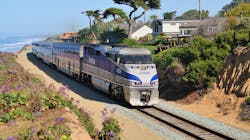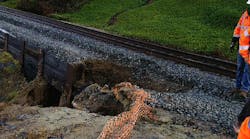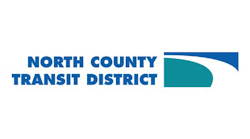Phase 4 of Del Mar Bluffs Stabilization project complete
A long-term, six-phase effort to stabilize portions of the coastal bluffs in Del Mar, Calif., marked the end of Phase 4 after seven months of work. The stabilization project is being led by the San Diego Association of Governments (SANDAG) and the North County Transit District (NCTD) partnership with the city and Caltrans District 11.
“It is always a pleasure to announce the completion of a project that will enhance safety and ensure the security of the Del Mar Bluffs. Improving the condition of this section of the LOSSAN corridor is a top priority for NCTD,” said Tony Kranz, NCTD Board chair and Encinitas councilmember.
The picturesque rail line that runs along the bluffs carries both freight and passenger rail traffic. Bluff retreat and other natural events have caused reliability and safety concerns, which the stabilization project will work to fix.
SANDAG explains the bluffs experience roughly six inches of erosion on average every year mostly caused by storm and irrigation runoff. The drainage improvements that will direct channel water across the bluffs and to the ocean will help protect the bluffs. The track on the coastal bluffs is part of the 351-mile Los Angeles – San Diego – San Luis Obispo (LOSSAN) rail corridor, which links San Diego and Los Angeles with northern points.
The $5.8-million Phase 4 saw the installation of smaller support columns to stabilize localized areas and sea walls, the construction of a drainage channel on top of the bluffs, the repair of concrete channels and storm chute outfalls and stabilization of existing headwalls.
“The completion of this work demonstrates significant progress in our multi-phased strategy to secure the Del Mar Bluffs and ensure continued reliability of this important rail corridor,” said SANDAG Chair and Encinitas Mayor Catherine Blakespear.
The previous three phases of the stabilization project involved work along the Del Mar Bluffs between Coast Boulevard and Torrey Pines State Beach and included the installation of more than 230 concrete and steel support columns and improvements to drainage infrastructure to protect the bluffs from future erosion.
Phase 5 is scheduled to begin in 2022 and will address additional seismic and critical stabilization needs, including the installation of more support columns and replacing aging drainage structures. Phase 6 will continue to provide long-term rehabilitation and stabilization work, including protecting the base of the bluffs against additional bluff retreat. Recent erosion of the Del Mar Bluffs has highlighted the urgent need to identify a feasible long-term solution for the corridor.
Funding Phase 5 and Phase 6 has been a challenge, with SANDAG and NCTD requesting $100 million from the state to accelerate the two phases. The final two phases did secure $36.2 million from the California Transportation Commission in December 2020 that was part of a larger $106-million award for rail projects in the San Diego region. In May 2020, SANDAG and NCTD were awarded an $11.57-million grant by the Federal Railroad Administration through the Federal-State Partnership for State of Good Repair Program for the stabilization project.
While SANDAG and NCTD work to stabilize the bluffs, SANDAG is seeking additional funding to speed up moving the bluffs inward as a long-term strategy.
“The Del Mar bluff stabilization efforts address the immediate concern to preserve track-bed support and ensure safe, reliable rail service for passengers and freight movement,” said Del Mar Mayor Terry Gaasterland. “The city of Del Mar, SANDAG, NCTD and Caltrans have worked together to complete the Phase 4 bluff stabilization. I applaud their unwavering commitment to the long-term goal of removing the railroad from the bluffs.”

Mischa Wanek-Libman | Group Editorial Director
Mischa Wanek-Libman is director of communications with Transdev North America. She has more than 20 years of experience working in the transportation industry covering construction projects, engineering challenges, transit and rail operations and best practices.
Wanek-Libman has held top editorial positions at freight rail and public transportation business-to-business publications including as editor-in-chief and editorial director of Mass Transit from 2018-2024. She has been recognized for editorial excellence through her individual work, as well as for collaborative content.
She is an active member of the American Public Transportation Association's Marketing and Communications Committee and served 14 years as a Board Observer on the National Railroad Construction and Maintenance Association (NRC) Board of Directors.
She is a graduate of Drake University in Des Moines, Iowa, where she earned a Bachelor of Arts degree in Journalism and Mass Communication.



